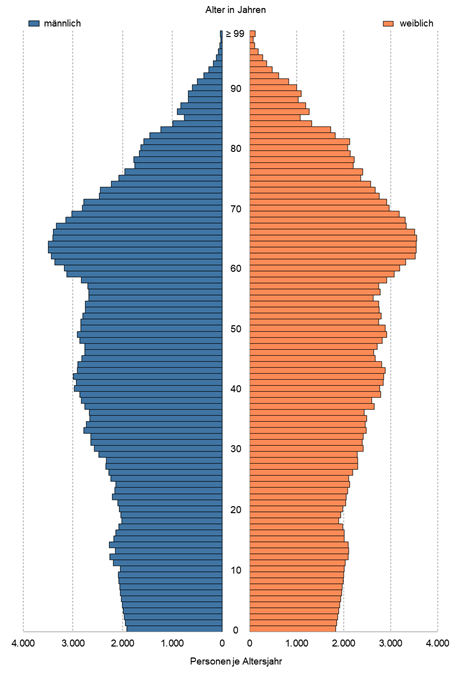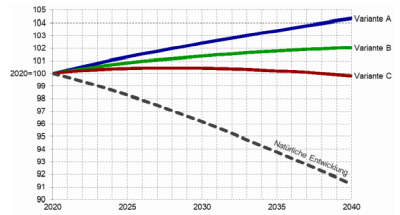Population Projection
S&W has a long experience in the development and application of demographic forecast models. Population and household forecast models are central components of dynamic spatial development simulations such as the IRPUD or ILUMASS model. S&W's demographic forecast models are continuously developed and adapted to new framework conditions (e.g. refugee influx, COVID-19 pandemic).
The S&W population forecast model is a cohort component model with a deterministic forecast approach. Taking into account empirically determined assumptions on natural population development and migration behaviour, the population is extrapolated and forecast annually at the spatial level of districts, cities, municipalities or districts, differentiated by age cohorts and gender, up to the intended target year. The assumptions to be selected are based in particular on the developments in the past years (reference period) in the sense of a status quo forecast. Local special effects or existing land reserves can optionally be taken into account. In most cases, different variants of population development are calculated. The results are presented graphically and cartographically and are usually summarised in an easy-to-understand report.


Population pyramid of the base year (left) and of the target year (right)
The most important element of a population projection is the initial population data of the base year, which should be up-to-date, complete and free of errors in order to ensure the most accurate population update possible. The S&W population forecast model enables a factual differentiation of the population by age (100) and sex (2). The data basis can be either data from official statistics or data from the population registers of the municipalities.
The simulation of the population development takes place in annual steps. In the "natural development" sub-model, the population cohorts are updated in a flow-oriented manner according to the assumptions made about year-specific fertility and mortality rates. In the process, the persons living at the beginning of the respective simulation year are multiplied by their corresponding age-specific survival probabilities (1 - mortality probability). The women still alive at the end of the year in the fertile age groups are multiplied by the projected age-specific fertility rates to determine the number of live births. These are then reduced by the expected infant deaths to be added to the population at the end of the simulation year as the 0- to under-1-year-old group. The fertility assumptions are based on corresponding statistical evaluations in the reference period. A constant fertility rate is generally assumed over the forecast period, although the age of mothers may continue to increase slightly in the future. The mortality assumptions are based on current statistical mortality tables. As a rule, a slight increase in future life expectancy is expected over the forecast period and a further equalisation of the sexes is assumed.
After running the "natural population development" sub-model, the "migration" sub-model is applied in each simulation year. In this sub-model, the age- and gender-specific external and internal migration movements are simulated on the basis of assumed migration probabilities. The S&W population forecast model allows the calculation of migration movements both via assumptions on age- and gender-specific external and internal migration balances and via a flow-oriented distribution approach with assumptions on age- and gender-specific external and internal continuation rates and migration quotas. The method is determined in consultation with the client after an intensive explorative data analysis of the migration data available.

Projected relative development of population in variants
The module "Land Reserve" is an optional component of the sub-model "Migration". It has the effect that in each individual simulation year the remaining residential building capacities are updated and taken into account. Particularly in strongly growing cities and municipalities without large building land reserves in the outer areas (redensification potentials are integrated in the basic model), this can lead to adjustments of the migration assumptions and a restriction of further immigration when the land capacity limit is approached or exceeded.

